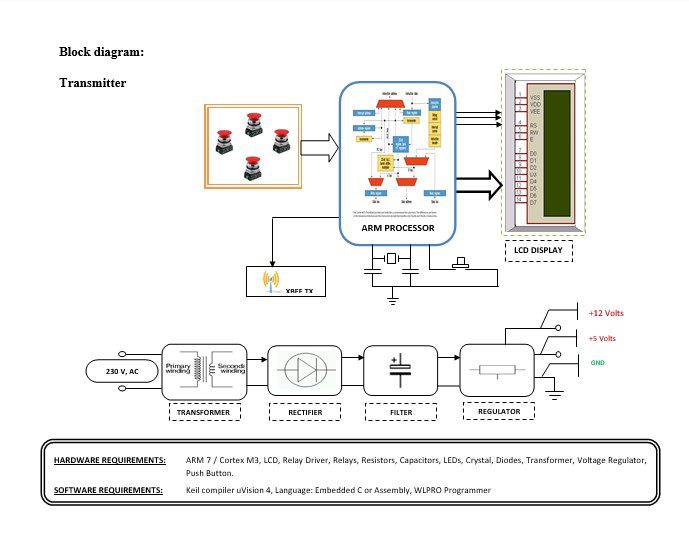Table of Contents
Introduction:


To simplify daily work an office should be as open as possible for employees and guests. Security issues are traditionally dealt with by the use of locks, keys, id-cards, passwords, and active infrared (IR) or passive infrared (PIR) detectors. Such equipment for passage control or detection of motion patterns requires proper placement. Video cameras with image recognition can distinguish authorized persons but are regarded as intrusive from a personal integrity perspective.
To limit annoyance and intervention from a rigorous security system there is a need for solutions that, less awkwardly, can identify suspicious events and behavior patterns and prevent theft. Passive RFID tags, attached to assets, are used to identify and detect theft in shopping malls. This requires assets to pass close to a tag-reader due to their limited range often less than a meter. The reading can also be hindered by putting the tagged asset in a metal foil-covered bag.
Surveillance using a global positioning system (GPS), is popular for tracking larger assets such as boats, cars, and containers where one can equip a node with a processor, a GPS receiver, and a wide area wireless link, such as GSM/GPRS or 3G. However, this is too energy ravenous and costly for small and cheap office assets. For personal assets, we need a solution that is both selective and that can work in an open environment visited by many persons and be yet less intrusive than video cameras from a personal integrity point of view. Our solution, partly inspired by the active badge concept, is based on wireless sensor networks used to detect and communicate location proximity or containment information combined with a middleware STITCH for the coordination of distributed activities.




Block Diagram explanation;
Power supply unit:
This section needs two voltages viz., +12 V & +5 V, as working voltages. Hence specially designed power supply is constructed to get regulated power supplies.
ZigBee technology:
ZigBee is the name of a specification for a suite of high-level communication protocols using small, low-power digital radios based on the IEEE 802.15.4 standard for wireless personal area networks (WPANs).
- Very low cost, low power consumption two-way, wireless communication standard for automation, toys & PC peripherals.
- Low power consumption: 6 months to 5 years battery life for most applications.
- Low cost: At least half the cost of Bluetooth solutions.
- The high density of nodes per network: 250 nodes per network, multiple co-located networks.Data rate requirements: Few bits to 250kbps sufficient.
ARM processor:
ARM is a computer processor-based RISC architecture. A RISC-based computer design approach means ARM processors require significantly fewer transistors than typical processors in average computers. This approach reduces costs, heat, and power use. The low power consumption of ARM processors has made them very popular:
The ARM architecture (32-bit) is the most widely used in mobile devices, and the most popular 32-bit one in embedded systems.
ARM processor features include:
- Load/store architecture.
- An orthogonal instruction set.
- Mostly single-cycle execution.
- A 16×32-bit register
- Enhanced power-saving design.
Sensor:
Passive Infrared Sensor
A Passive Infrared sensor (PIR sensor) is an electronic device that measures infrared (IR) light radiating from objects in its field of view. PIR sensors are often used in the construction of PIR-based motion detectors. Apparent motion is detected when an infrared source with one temperature, such as a human, passes in front of an infrared source with another temperature, such as a wall. This is not to say that the sensor detects the heat from the object passing in front of it but that the object breaks the field which the sensor has determined as the “normal” state. Any object, even one the same temperature as the surrounding objects will cause the PIR to activate if it moves in the field of the sensors.
Buffers:
Buffers do not affect the logical state of a digital signal (i.e. a logic 1 input results in a logic 1 output whereas logic 0 input results in a logic 0 output). Buffers are normally used to provide extra current drive at the output but can also be used to regularize the logic present at an interface.
Drivers:
This section is used to drive the relay where the output is the complement of input which is applied to the drive but the current will be amplified.
Relays:
It is an electromagnetic device that is used to drive the load connected across the relay and the o/p of the relay can be connected to the controller or load for further processing.
Indicator:
This stage provides a visual indication of which relay is actuated and deactivated, by glowing respective LED or Buzzer.
Methodology:
A block diagram which is shown above is divided into two parts that are transmitter and receiver. The transmitter part is which is in the control room which can be controlled from a remote area using ZIGBEE as a communication protocol. The person at the transmitting end controls the robot of the remote areas using key inputs by using a password in MSP 430 controller if any person detects alive in the remote area then the sensor detects it and it sends coordinates of the location to the control area using ZigBee.
Advantages and disadvantages:
Advantages:
- Less cost
- Less complexity
- By using this robot we save humans and protect our country
Disadvantages:
1. When power is off, then the total system is off, so all ways we required a battery.
2. It needs a person to operate this robot every time
Applications:
- In military applications to detect the presence of human beings.
- In Rescue operations where human reach is not possible.
- In Warfield-affected areas, to detect the presence of bombs.




